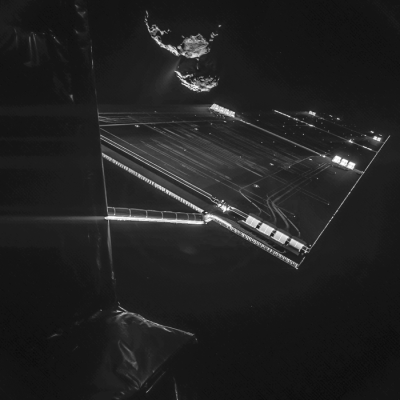You may have heard a lot about the recent accomplishment from the European Space Agency (ESA): they managed to land a mobile laboratory on a comet in order to learn about its composition and date the contents of the comet. However, many people are unaware of the actual process of the mission and what it’s really for.
Here’s the first mind-blowing fact: this project was approved over 20 years ago! It was approved in 1993 as a Cornerstone Mission in ESA’s Horizons 2000 science program, where there are several programs that have already been seen through, as well as others that have yet to begin.
These projects take far more time and money than most people even realize. Some take even billions of dollars to create! A few hundred million dollars on a NASA project is actually considered pretty cheap for a space project.
A scientist by the name of Russell Palma recently gave a talk at Gustavus on his involvement in the Stardust mission, which was the collection of particles from a comet and studying their samples.
His mission was to use these particles to hopefully be able to more accurately calculate and determine the age of the solar system because these particles have been largely unchanged since the creation of our solar system.
They had to calculate the velocity of the comet and get their satellite to follow it and raise a plate to collect the particles in order to process them back on Earth. He even stated that processing one sample takes four years. These are lifelong projects for the scientists involved, and the Rosetta will span many years after its mission is over.
Rosetta, named after the Rosetta Stone, had one mission: to chase down and drop a lander on a comet in order to analyze its geological contents. It also had several other smaller missions on its way to catch the comet, including the analysis of several extraterrestrial bodies and formations as it kept using planetary gravitational fields to assist its flight, basically sling-shoting itself through the solar system.
It first used Earth’s gravity to slingshot to Mars, where it swung around Mars and flew back to Earth, when it once again used Earth’s gravity to slingshot past Mars.
It reached the asteroid field before falling back towards Earth where it used Earth’s gravity one final time to sling itself back to the asteroid field. It actually got so far out into space that it was nearly one billion kilometers, or 621,371,192 miles away from the Sun, so its solar panels were not of very much use.
At this point, it went into “hibernation” until around January 2014, when it fired its engines in order to chase down the comet. Finally, here we are, with its lander Philae on the comet.
Recently, it was reported that Philae’s landing did not go as expected. Its landing anchors failed to deploy, meaning that when it hit the comet it bounced and actually landed nearly a kilometer away from its intended landing zone. It hit a sort of wall that stopped its movement, but shaded it from sunlight so it couldn’t charge its batteries. The workers at NASA scrambled into action, reportedly doing a 57 hour mission before Philae’s batteries fully drained.
The lander still managed to send the results before it shut down. Their hope is that, in time, the comet’s movement will allow sunlight to reach Philae and charge its battery so they can reawaken it for a follow-up mission.
This mission is considered very important because it could tell us about the composition of things older than our solar system. This could lead to future endeavors and hopefully discovering more about the universe outside of our solar system. I’m personally extremely excited to see the future missions that NASA plans to launch and what they might discover.
-Cameron MacDonald

